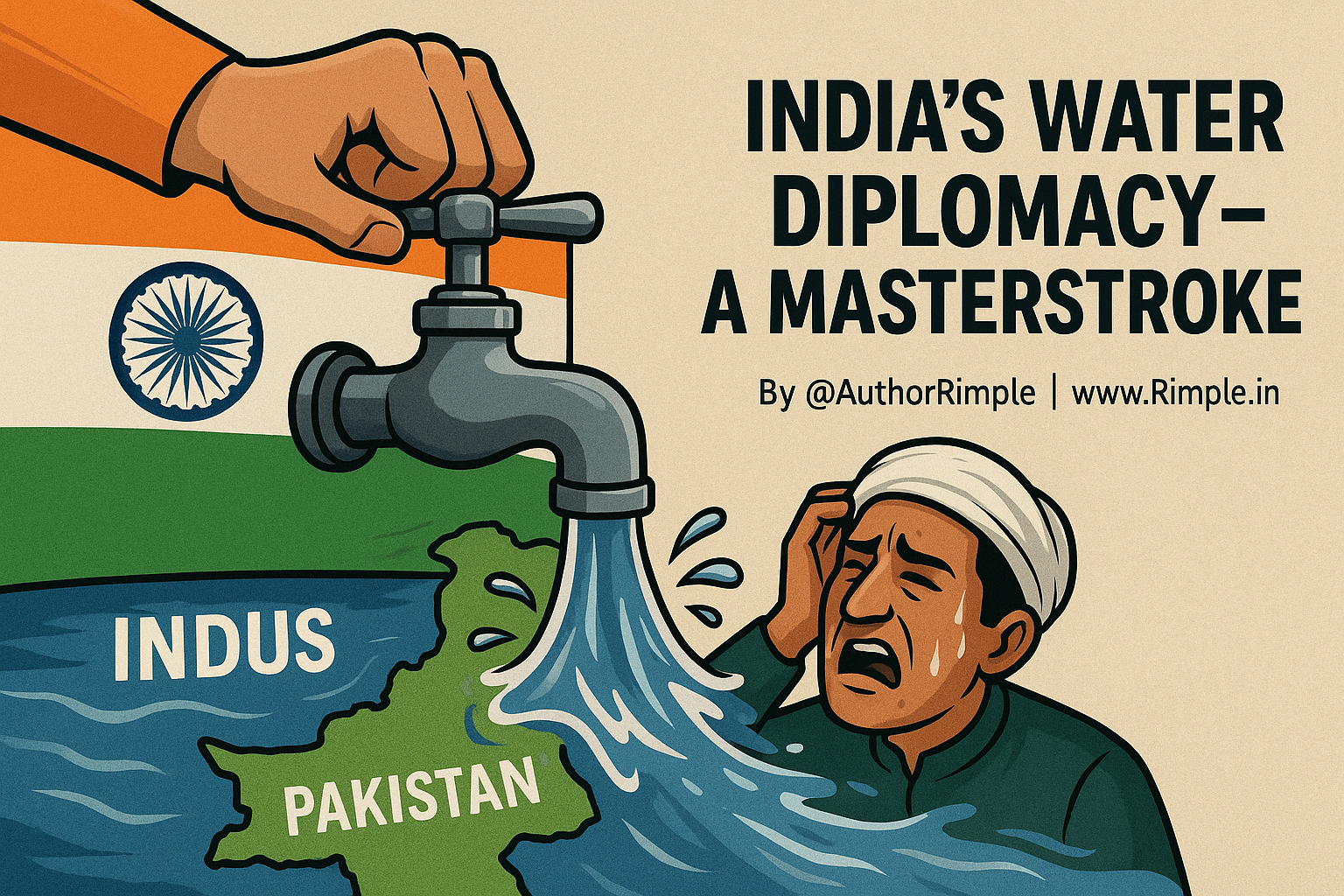On April 22, 2025, a brutal terrorist attack in Pahalgam, Jammu and Kashmir, killed 26 civilians, asking them if they are Hindus and were asked to read Kalma then shot brutally. Orchestrated by Pakistan-backed militants. India swiftly responded with Operation Sindoor, launching precision strikes and a series of punitive measures against Pakistan. While these actions included diplomatic and military steps, India’s water strategy—centered on suspending the Indus Waters Treaty (IWT)—has emerged as a uniquely powerful weapon, choking Pakistan’s lifeline with devastating precision. In this article, we focus exclusively on India’s water strategy, a brilliant and calculated move that has left Pakistan reeling, proving that India is in no mood to spare a terrorist-supporting nation. From April 22 to May 25, 2025, India’s actions have reshaped the region’s hydro-politics, and we’ll explore each step and its profound impacts, alongside Pakistan’s desperate pleas and India’s strategic talks with Afghanistan to tighten the noose further.
Action 1 (April 23, 2025): Suspension of the Indus Waters Treaty
India suspended the 1960 Indus Waters Treaty, citing Pakistan’s role in the Pahalgam attack. Foreign Secretary Vikram Misri announced the treaty “in abeyance” until Pakistan ends terrorism, halting data sharing and water flow commitments. India closed the Baglihar Dam gates on the Chenab River, stopping water to Pakistan.
Impact 1: The suspension disrupted Pakistan’s access to river flow data, crippling irrigation for 80% of its farmland, which accounts for 24% of GDP and employs 45% of its workforce. The Baglihar closure slashed Chenab flows, threatening crops like wheat and rice in Punjab and Sindh. Pakistan’s farmers faced immediate sowing disruptions, with long-term risks of food insecurity.
Impact Timeline: Short-term (1-3 months)—irrigation chaos; Long-term (1-2 years)—economic collapse and food crisis.
Action 2 (April 24, 2025): Flushing Operations at Baglihar and Salal Dams
India initiated flushing and desilting at the Baglihar and Salal Dams on the Chenab River during the dry season, defying IWT norms that schedule such activities for monsoons.
Impact 2: The flushing reduced Chenab flows to Pakistan’s Punjab and Sindh, where 90% of crops like rice and cotton depend on the river. Sindh’s Hyderabad and Sukkur reported parched fields, forcing reliance on depleting groundwater, escalating costs. This pushed Pakistan’s per capita water availability toward 500 cubic meters, intensifying its water scarcity crisis. Protests in Sindh fueled “Sindhudesh” demands. Impact Timeline: Short-term (1-2 months)—crop failures; Long-term (3-5 years)—economic and social unrest.
Action 3 (April 25, 2025): Roadmap to Halt Indus Water Flow
Jal Shakti Minister Gajendra Singh Shekhawat announced a three-step plan to ensure “not a single drop” flows to Pakistan, including monthly dam flushing, canal projects, and reviving the Tulbul Navigation Project on the Jhelum River at Wular Lake.
Impact 3: The announcement caused panic among Pakistan’s farmers, fearing desertification in Punjab and Sindh. The Tulbul project’s revival threatens to regulate Jhelum flows, potentially flooding or starving Pakistan’s Punjab. Separatist sentiments surged in Sindh, with “Sindhudesh” activists appealing to PM Narendra Modi, and in Balochistan. Long-term canal projects could cut Pakistan’s water by 10-15%.
Impact Timeline: Short-term (2-6 months)—unrest; Long-term (5-10 years)—economic and territorial collapse.
Action 4 (May 1, 2025): Complete Stoppage of Ravi River Flow
India halted all Ravi River flow at the Madhopur Headworks after completing the Shahpurkandi Dam, redirecting water to Punjab and northern hill states.
Impact 4: The stoppage devastated 150,000 acres in Pakistan’s Narowal and Shakargarh districts. Lahore faced drinking water shortages, with 2,000 farmers burning Modi effigies in Gulberg. The move disrupted $2 billion in rice exports, fueling Sindh’s “Sindhudesh” movement.
Impact Timeline: Short-term (1-3 months)—water and economic crises; Long-term (2-5 years)—separatist momentum.
Action 5 (May 3, 2025): Baglihar Dam Closure
India shut the Baglihar Dam gates on the Chenab River, completely stopping water flow to Pakistan.
Impact 5: The closure caused record-low Chenab levels, with people crossing the river on foot in Jammu’s Akhnoor. Pakistan’s Punjab faced irrigation shortages, threatening $1 billion in cotton exports. Protests escalated in Sialkot and Gujrat, with Pakistan’s Indus River System Authority (IRSA) reporting a 90% flow reduction.
Impact Timeline: Short-term (1-2 months)—crop losses; Long-term (1-3 years)—economic destabilization.
Action 6 (May 4, 2025): Kishanganga Dam Flushing
India conducted flushing at the Kishanganga Dam on the Jhelum River, reducing flows to Pakistan.
Impact 6: The flushing cut water to Pakistan’s Muzaffarabad, affecting 80,000 acres and $200 million in rice crops. Pakistan’s Foreign Office called it a “humanitarian crime,” but India’s MEA countered, “Our dams target terror.” The action fueled “Sindhudesh” protests in Sindh.
Impact Timeline: Short-term (1-2 months)—crop losses; Long-term (1-3 years)—social unrest.
Action 7 (May 5, 2025): Ratle Project Expansion
India accelerated work on the Ratle hydroelectric project on the Chenab River, conducting flushing operations to boost reservoir capacity.
Impact 7: The flushing caused flash floods in Pakistan’s Khyber Pakhtunkhwa, submerging farmlands near Peshawar and damaging $100 million in wheat crops. Pakistan’s irrigation minister, Jam Khan Shoro, called it “water genocide.” The floods intensified separatist calls in Balochistan and Sindh.
Impact Timeline: Short-term (1-6 months)—crop and infrastructure losses; Long-term (3-7 years)—reduced water and power supply.
Action 8 (May 8, 2025): Salal and Baglihar Dam Water Release
India opened three gates of the Salal Dam and two gates of the Baglihar Dam, releasing 300,000 cusecs into the Chenab River to manage rising levels from rainfall.
Impact 8: The release triggered flood alerts in Pakistan’s Sialkot, Gujrat, and Lahore, with Chenab flows at Head Marala surging from 3,100 to 28,000 cusecs. Pakistan’s IRSA issued late warnings due to no data sharing. The floods damaged $50 million in crops and infrastructure. Indian officials called it “routine maintenance,” but the timing—post-Pakistan’s ceasefire violation—sent a clear message.
Impact Timeline: Short-term (1-2 months)—flood losses; Long-term (1-3 years)—eroded governance trust.
Action 9 (May 10, 2025): Tightened Control on Chenab and Jhelum Rivers
At 10:00 AM, India reduced water flow by 70% from the Salal Dam (Chenab) and Uri Dam (Jhelum), and prepared to release 600,000 cusecs from the Tulbul Navigation Project.
Impact 9: The flow reduction starved 200,000 acres in Pakistan’s Punjab and Muzaffarabad. Shekhawat’s statement, “Pakistan’s terrorism will face a dry future,” resonated. The Tulbul threat kept Pakistan’s farmers in panic, with IRSA unable to predict India’s moves. This crippled Pakistan’s agriculture, which accounts for 24% of GDP.
Impact Timeline: Short-term (1-3 months)—agricultural losses; Long-term (2-5 years)—economic instability.
Action 10 (May 11, 2025): Chenab Surge from Baglihar Dam
At 6:00 AM, India released 300,000 cusecs from the Baglihar Dam into the Chenab.
Impact 10: The surge flooded 70,000 acres in Sialkot and Gujranwala, damaging $100 million in wheat crops. Punjab CM Maryam Nawaz accused India of “deliberate flooding,” but MEA’s Randhir Jaiswal retorted, “Our water management counters terror.” The floods disrupted CPEC projects near Wazirabad, costing China $50 million.
Impact Timeline: Short-term (1-2 months)—crop and infrastructure damage; Long-term (1-3 years)—strained China-Pakistan ties.
Action 11 (May 13, 2025): Ravi River Flow Reduction
At 6:00 AM, India reduced Ravi River flow by 60% at Madhopur Headworks, citing “security.”
Impact 11: The cut impacted 150,000 acres in Narowal and Shakargarh. Protests in Lahore’s Gulberg saw 2,000 farmers burn Modi effigies. Pakistan threatened the Ranjit Sagar Dam but was deterred by India’s S-400 systems. The MEA’s “Terror voids water-sharing” stance disrupted $500 million in wheat exports.
Impact Timeline: Short-term (1-3 months)—water shortages; Long-term (2-5 years)—agricultural decline.
Action 12 (May 13, 2025): Jhelum River Flow Reduction at Uri Dam
At 6:00 AM, India cut Jhelum flow by 50% at the Uri Dam.
Impact 12: The reduction affected 100,000 acres in Muzaffarabad and Kotli. Shoro called it “water genocide” and sought UN intervention. Jaiswal responded, “Water is our sovereign tool to counter terror.” The cut disrupted $2 billion in rice exports, fueling “Sindhudesh” demands.
Impact Timeline: Short-term (1-3 months)—export losses; Long-term (2-5 years)—separatist movements.
Action 13 (May 14, 2025): Chenab Surge from Ranjit Sagar Dam
At 8:00 AM, India released 150,000 cusecs from the Ranjit Sagar Dam into the Chenab.
Impact 13: The surge flooded 70,000 acres in Sialkot and Gujranwala, damaging $200 million in canal infrastructure. Maryam Nawaz accused India of “deliberate flooding,” but Jaiswal countered, “Our water management counters terror.” The floods disrupted CPEC projects, costing China $100 million.
Impact Timeline: Short-term (1-2 months)—infrastructure losses; Long-term (1-3 years)—weakened CPEC.
Action 14 (May 16, 2025): Sutlej Flow Reduction at Bhakra Dam
At 6:00 PM, India reduced Sutlej flow by 55% at the Bhakra Dam.
Impact 14: The cut impacted 120,000 acres in Kasur and Okara, slashing $1 billion in cotton exports by 20%. Shekhawat stated, “Water is our weapon against terror.” Maryam Nawaz sought UN mediation, but protests in Lahore’s Anarkali Bazaar drew only 1,500 farmers. Jaiswal reiterated, “Water is our sovereign right.”
Impact Timeline: Short-term (1-3 months)—export and water crises; Long-term (2-5 years)—economic sabotage.
Action 15 (May 17, 2025): Kishanganga Dam Flushing
India conducted flushing at the Kishanganga Dam on the Jhelum River, reducing flows to Pakistan.
Impact 15: The flushing cut water to Muzaffarabad, affecting 80,000 acres and $200 million in rice crops. Pakistan’s Foreign Office called it a “humanitarian crime,” but India’s MEA countered, “Our dams target terror.” ISRO monitoring ensured no civilian harm. “Sindhudesh” protests intensified.
Impact Timeline: Short-term (1-2 months)—crop losses; Long-term (1-3 years)—social unrest.
Action 16 (May 18, 2025): Salal Dam Flow Reduction
India reduced Chenab flow by 50% at the Salal Dam.
Impact 16: The reduction starved 90,000 acres in Pakistan’s Punjab. Shoro accused India of “economic sabotage.” The move disrupted $250 million in wheat exports, with protests in Lahore weakening. India’s strategy kept Pakistan off-balance.
Impact Timeline: Short-term (1-3 months)—agricultural losses; Long-term (2-5 years)—economic strain.
Action 17 (May 20, 2025): Chenab Flow Reduction at Baglihar Dam
India reduced Chenab flow by 60% at the Baglihar Dam.
Impact 17: The reduction affected 100,000 acres in Sialkot and Gujrat. Pakistan’s Foreign Office sought World Bank intervention, but Jaiswal stated, “Our rivers serve our security.” The action disrupted $300 million in cotton exports, intensifying unrest in Sindh.
Impact Timeline: Short-term (1-3 months)—crop losses; Long-term (2-5 years)—social instability.
Action 18 (May 23, 2025): Jhelum Surge from Tulbul Project
India released 400,000 cusecs from the Tulbul Navigation Project at Wular Lake into the Jhelum.
Impact 18: The surge flooded 50,000 acres in Kotli and Mirpur, damaging $150 million in infrastructure. Pakistan’s Foreign Office sought World Bank mediation, but Jaiswal reiterated, “Our rivers counter terror.” The floods fueled Balochistan’s separatist calls.
Impact Timeline: Short-term (1-2 months)—flood damage; Long-term (1-3 years)—political instability.
Action 19 (May 24, 2025): Sutlej Flow Reduction at Harike Barrage
India reduced Sutlej flow by 50% at the Harike Barrage.
Impact 19: The reduction impacted 100,000 acres in Pakistan’s Bahawalpur district. Shoro called it “water terrorism.” The cut disrupted $200 million in cotton exports, with protests in Karachi fizzling out. Jaiswal stated, “Our water strategy targets Pakistan’s terror economy.”
Impact Timeline: Short-term (1-3 months)—export losses; Long-term (2-5 years)—economic decline.
Pakistan’s Nuclear Facilities and Water Dependency
Pakistan operates six nuclear facilities and two research reactors, all heavily reliant on water for cooling and operations, requiring approximately 6-12 million gallons daily. India’s control over the Chenab, Jhelum, and Indus rivers directly threatens these facilities, undermining Pakistan’s strategic capabilities.
- Chashma Nuclear Power Complex (near Chashma, Punjab) – Pakistan-owned, with Chinese technical assistance, relies on Chenab River water for cooling four reactors.
- Karachi Nuclear Power Plant (near Karachi, Sindh) – Pakistan-owned, Chinese-supported, depends on Indus River water and local aquifers, now strained by reduced flows.
- Khushab Nuclear Complex (near Khushab, Punjab) – Pakistan-owned, used for plutonium production, draws water from the Jhelum River, impacted by Uri and Kishanganga reductions.
- Kahuta Research Laboratories (near Rawalpindi) – Pakistan’s primary enrichment facility, reliant on Indus basin water sources, vulnerable to flow cuts.
- Gadwal Uranium Enrichment Plant (near Wah Cantonment) – Pakistan-owned, uses Jhelum River water for processing, threatened by India’s actions.
- Dera Ghazi Khan Nuclear Facility (near Dera Ghazi Khan, Punjab) – Pakistan-owned, involved in uranium processing, depends on Indus River water, affected by flow reductions.
- Pakistan Research Reactor-1 (PARR-1, near Islamabad) – Operable research reactor, draws from local Indus basin sources, at risk from water shortages.
- Pakistan Research Reactor-2 (PARR-2, near Islamabad) – Operable research reactor, relies on Indus basin water, impacted by India’s strategy.
India’s water strategy, by reducing flows in the Chenab, Jhelum, and Indus rivers, threatens the operational stability of these facilities, particularly Chashma and Khushab, which are most vulnerable to water shortages. A sustained reduction could force Pakistan to scale back nuclear operations, weakening its strategic capabilities—a masterstroke by India’s leadership.
Sindh’s Water Crisis: Fueling Unrest and Sindhudesh Movement
India’s water strategy has plunged Sindh into chaos, with the Indus River, the province’s lifeline, reduced to a trickle by India’s upstream control. ISRO satellite images reveal dried-up riverbeds in Hyderabad, Sukkur, and Larkana, turning fertile lands into barren deserts. Sindh, reliant on the Indus for 90% of its agriculture, faces unprecedented water scarcity, devastating crops like rice and cotton. On May 20, 2025, enraged mobs in Hyderabad torched the homes of two Pakistan Army officers, blaming the military for diverting water to Punjab. On May 22, protesters in Sukkur set fire to the Pakistan Muslim League-Nawaz (PML-N) office, targeting Punjab-based leaders like Maryam Nawaz for neglecting Sindh’s plight.
The “Sindhudesh” movement has gained massive traction, with separatist leaders rallying crowds to demand independence, citing India’s water strategy as proof of Pakistan’s inability to govern. Social media posts show banners in Karachi reading, “Modi, Save Sindh,” as locals appeal for Indian support in their liberation struggle. Outside Punjab, water flow has virtually ceased, with Balochistan and Khyber Pakhtunkhwa also reporting dry canals, amplifying unrest. India’s calculated moves have exposed Pakistan’s internal fractures, with Sindh’s chaos threatening to unravel the nation’s unity.
Water Crisis Sparks Unrest Across Pakistan’s Other Regions
Beyond Sindh, India’s water strategy has triggered widespread unrest in Balochistan, Khyber Pakhtunkhwa (KPK), and even parts of Punjab, as river flows dwindle. ISRO satellite images show cracked, dry riverbeds in Balochistan’s Quetta and Gwadar, where the Chenab and Indus tributaries have ceased flowing, crippling agriculture and drinking water supplies. On May 18, 2025, protests erupted in Quetta, with locals attacking government offices, accusing Islamabad of abandoning them. The Baloch Liberation Army seized the moment, distributing pamphlets in Turbat on May 21, declaring, “No water, no Pakistan,” fueling separatist fervor.
In KPK, Peshawar and Kohat saw violent demonstrations on May 19, with farmers burning effigies of PM Shehbaz Sharif after Jhelum River flows dropped, affecting 100,000 acres of farmland. Southern Punjab, typically prioritized for water, faced shortages in Bahawalpur after India’s Sutlej flow cuts, leading to protests on May 24 where locals vandalized irrigation department offices. Outside Punjab, water flow has virtually ceased, with Balochistan and KPK reporting dry canals, amplifying unrest. India’s strategic water control has laid bare Pakistan’s governance failures, pushing these regions toward rebellion and weakening the nation’s cohesion.
Note: Soon Balochistan and Sindhudesh will be new countries and not a part of Pakistan. Balochistan has already declared its independence in mid-May 2025, UN will soon recognize it. And India might be the first country in the world to have Balochistan Embassy.
Separatist Freedom Threatens Pakistan’s Nuclear Arsenal: Who Will Control the Chaos?
India’s water strategy has pushed Pakistan to the brink, fueling separatist movements in Sindh, Balochistan, and Khyber Pakhtunkhwa (KPK), regions housing critical nuclear and ammunition facilities. If Sindhudesh or Balochistan break free, Pakistan risks losing control of the Karachi Nuclear Power Plant in Sindh, Chashma Nuclear Power Complex and Khushab Nuclear Complex in Punjab, and Kahuta Research Laboratories and Gadwal Uranium Enrichment Plant near KPK, along with ammunition depots like the Wah Cantonment Ordnance Complex in Punjab and smaller arms facilities in KPK’s Dera Ismail Khan. The fear is real: these facilities could fall into the hands of separatist groups or, worse, jihadi elements, posing a grave threat to global security.
ISRO satellite imagery showing parched riverbeds in Karachi, Quetta, and Peshawar has intensified unrest, with locals blaming Pakistan’s government for failing to counter India’s water chokehold. Should these regions gain independence, the question looms—who will secure these dangerous assets? Global powers may be forced to intervene, potentially led by the UN or a coalition of nations, to neutralize nuclear warheads and secure ammunition to prevent misuse by terrorists. India’s water strategy, by drying up rivers and sparking rebellion, has exposed Pakistan’s fragility, threatening to dismantle its strategic core without firing a shot.
Critics who scoffed at India’s suspension of the Indus Waters Treaty, calling it “reckless” or “cruel,” including anti-national voices like Mehbooba Mufti, now stand exposed as shortsighted fools. They failed to grasp the genius of PM Modi and Jal Shakti Minister Gajendra Singh Shekhawat, whose water strategy could reshape South Asia’s security by weakening a terror-sponsoring state.
Pakistan’s Parliament and Media: Begging India for Mercy Amid Decades of Aggression
Pakistan’s parliament and media are gripped by panic as India’s water strategy tightens its chokehold, with leaders openly admitting that India has won this bloodless war.
On April 24, 2025, in a heated National Assembly session, Prime Minister Shehbaz Sharif confessed, “India’s control over our rivers is a death sentence for Pakistan’s economy,” pleading for India to restore water flows and seeking World Bank mediation.
On May 14, Foreign Office spokesperson Mumtaz Zahra Baloch, in a press briefing, admitted, “Without India releasing water, our fields and cities will die,” urging global intervention.
Bilawal Bhutto-Zardari, in a May 15 Geo News interview, lamented, “India holds our lifeline; we’re at their mercy,” a stark acknowledgment of Pakistan’s vulnerability.
Defence Minister Khawaja Asif, in a May 9 Dawn op-ed, warned, “If India doesn’t relent, Pakistan faces collapse,” despite his earlier nuclear threats.
Irrigation Minister Jam Khan Shoro, on May 13 ARY News, begged, “India must release water to save our farmers from ruin.”
Punjab CM Maryam Nawaz, in a May 14 press conference, pleaded, “India’s water blockade is killing Punjab; we need their mercy.”
On May 24, Foreign Minister Ishaq Dar told ARY News, “India’s strategy has crippled us; we implore them to open the dams,” seeking ICJ help but admitting defeat.
These desperate pleas expose Pakistan’s helplessness, a direct result of its decades-long aggression against India through cross-border terrorism, from the 1999 Kargil War to the 2008 Mumbai attacks and now the 2025 Pahalgam attack. India’s water strategy is long overdue justice for these provocations. Jawaharlal Nehru’s naive decision in 1960 to cede 80% of the Indus basin waters to Pakistan, despite its hostility, was a historic blunder that emboldened a terror-sponsoring state. The Modi government’s bold suspension of the Indus Waters Treaty and strategic control of rivers corrects this mistake, showcasing unmatched foresight. PM Modi and Jal Shakti Minister Gajendra Singh Shekhawat have turned India’s rivers into a weapon, forcing Pakistan to beg for survival while proving India’s dominance.
Anti-National Voices in India
Pro-Pakistan politicians like Mehbooba Mufti, PDP chief, criticized the Indus Waters Treaty suspension as “inhumane” in a May 15, 2025, statement, claiming it “punishes Pakistan’s civilians.” Her remarks, supporting a terror-sponsoring state, sparked outrage, with her labeled a “terrorist sympathizer.” Such anti-national rhetoric undermines India’s resolve to punish Pakistan for its decades-long aggression, including the 2025 Pahalgam attack.
Equally troubling, Congress leader Rahul Gandhi has echoed Pakistan’s narrative, weakening India’s stance. On May 17, 2025, in a public address in New Delhi, he called India’s water strategy “aggressive and unfair,” urging the Modi government to “reconsider the blockade to avoid humanitarian fallout in Pakistan.” His remarks, aired on NDTV, mirror Pakistan’s pleas, ignoring its history of terrorism from the 2008 Mumbai attacks to Pahalgam. Social media erupted with criticism, with Republic World branding him a “Pakistan apologist” for prioritizing a hostile nation’s interests over India’s security. Gandhi’s stance, seen as pandering to Pakistan’s victim narrative, has fueled accusations of anti-nationalism, betraying India’s fight against a terror-sponsoring state and undermining the Modi government’s strategic brilliance.
Well, it isn’t surprising if Rahul Gandhi or his family or his party is siding Pakistan. If they sided India, then it would be shocking, and not surprising.
India-Afghanistan Collaboration
On May 15, India discussed funding the Shahtoot Dam on Afghanistan’s Kabul River with Taliban officials. This could cut Pakistan’s water by 10-15%, impacting Khyber Pakhtunkhwa and the Tarbela Dam, which generates 20% of Pakistan’s electricity. India’s $2 billion investment strengthens this partnership.
India’s Strategic Brilliance
India’s water strategy—alternating droughts and floods—has crippled Pakistan’s agriculture (24% of GDP) and $3.7 billion in exports. By suspending the IWT, India leverages 80% of the Indus basin’s headwaters, reversing 1960 concessions. The strategy forces Pakistan to divert military funds to flood relief, weakening its LoC posture. PM Modi’s vow—“Pakistan will not get India’s water”—has turned dams into diplomatic missiles. Public sentiment on X calls it a “bloodless war,” cementing India’s dominance.
Conclusion
India’s water strategy since the April 22, 2025, Pahalgam attack has reshaped South Asia’s geopolitical landscape. From suspending the Indus Waters Treaty to manipulating river flows and aligning with Afghanistan, India has executed a series of calculated moves that have left Pakistan’s agriculture, economy, and nuclear capabilities in disarray. The desperate pleas from Pakistan’s leaders and the growing unrest in Sindh and Balochistan are testaments to the strategy’s effectiveness. India’s leadership has demonstrated unmatched foresight, turning a 65-year-old treaty into a tool of retribution and dominance. As Pakistan flounders, India stands firm, proving that water, in the hands of a resolute nation, can be more powerful than any weapon.
This hydro-diplomacy masterstroke proves India’s rivers are its strength, punishing Pakistan’s terrorism with unmatched precision.
Also Read:





